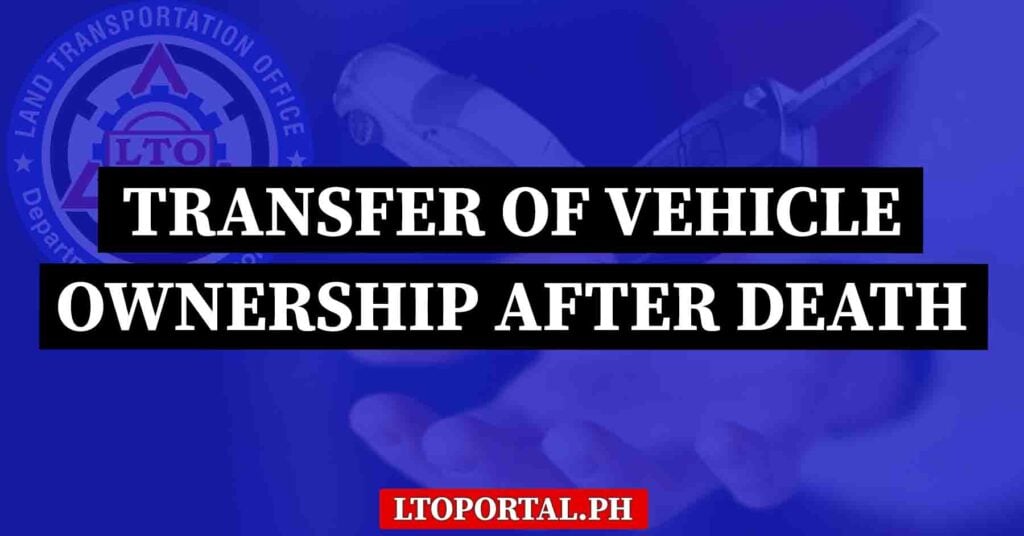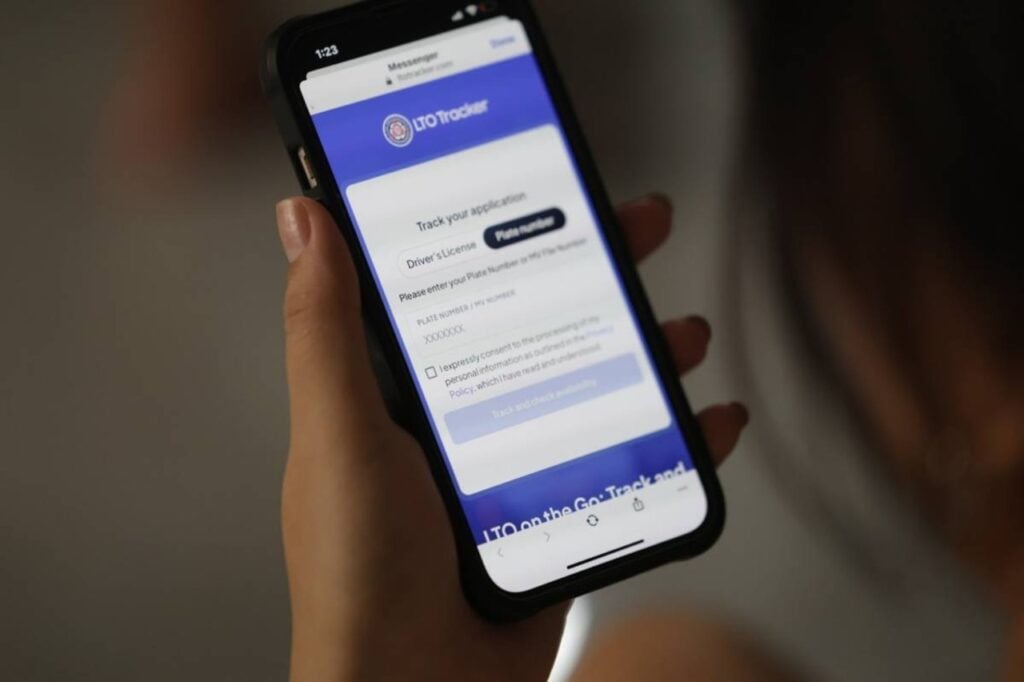When the registered owner of a motor vehicle passes away, the transfer of ownership becomes necessary before the car can be sold, registered, or legally used. The Land Transportation Office (LTO) has a structured process for transferring motor vehicle (MV) ownership in these cases so the rightful heir or buyer can legally use and register the vehicle. The process is simple and the fees are minimal, making it easier to avoid legal issues, registration problems, and liability disputes in the future.
This guide walks you through the requirements, procedures, fees, and timelines so heirs and buyers can navigate the process smoothly.

Why You Need to Transfer Ownership
If a car’s registered owner dies, the Certificate of Registration (CR) and other records under the LTO must reflect the rightful heir or new owner. This prevents legal issues such as:
- Inability to renew registration under the deceased’s name
- Complications in selling or disposing of the vehicle
- Questions of liability in case of accidents or violations
- Possible penalties for using an unregistered or improperly documented vehicles
- The vehicle may be subject to claims from creditors if the estate is unsettled.
By completing the transfer properly, the heirs get legal ownership and avoid legal or financial complications later on.
Who Needs to Do This?
Here’s a list of people who need to know how to transfer motor vehicle (MV) ownership when the registered owner dies:
- Surviving heirs: whether there is one heir (sole adjudication) or multiple heirs (extra-judicial settlement).
- Family members of the deceased owner: such as spouse, children, or siblings handling the estate.
- Executors or administrators of the estate: those legally tasked to settle the deceased’s properties.
- Buyers of a vehicle from an estate: individuals who purchased the motor vehicle from heirs or through estate settlement.
- Lawyers or estate representatives: assisting clients in legal transfers of property, including vehicles.
- Businesses or organizations: if the deceased owned a company-registered vehicle that needs transfer to successors or new owners.
- Anyone planning to sell or use the inherited vehicle: to make sure it is properly registered and legally transferred under their name.
Requirements
When transferring ownership of a motor vehicle (whether sold or inherited), the following documents are required:
- PNP-HPG Motor Vehicle Clearance Certificate – Original copy
- Duly accomplished Motor Vehicle Inspection Report – Original copy
- Insurance Certificate of Cover (electronically transmitted) – Original copy
- Valid government-issued ID of both vendor and vendee – Present original and submit photocopy
Accepted IDs include:- PhilID
- Philippine passport
- SSS
- UMID
- PhilHealth
- TIN
- Postal
- Voter’s
- Barangay
- PRC
- Senior Citizen
- OFW
- OWWA
- NCDA
- Solo Parent
- GSIS e-Card
- Seaman’s Boo
- GOCC ID
- HDMF
- DSWD certification
- IBP ID
- Confirmation of CR – Photocopy with original for presentation (if issued by another LTO Regional Office)
Additional Requirements
If the Vehicle is Inherited
If the vehicle is passed on to heirs, the requirements differ depending on whether the estate was settled extra-judicially or through court proceedings.
Extra-Judicial Settlement of Estate
- Certificate of Registration (CR) – Original copy
- Affidavit of publication of the Deed in a newspaper of general circulation for 3 consecutive weeks with clippings
- Death certificate, birth certificate, or marriage certificate – Photocopy (issued by PSA/NSO)
- Valid government-issued ID – Present original and submit photocopy (same list as above)
If there are two or more heirs:
- Deed of Extra Judicial Settlement of Estate – Original copy
If there is only one heir:
- Sole Adjudication – Original copy
Judicial Settlement of Estate
- Certificate of Registration (CR) or affidavit of loss – Original copy
- Court decision – Certified true copy
- Death certificate, birth certificate, or marriage certificate – Photocopy (issued by PSA/NSO)
- Valid government-issued ID – Present original and submit photocopy (same list as above)
Step-by-Step Process
Here are the steps to follow when you apply for LTO transfer of motor vehicle ownership if the owner is deceased
Step 1. Submit requirements at any LTO District or Extension Office.
- Evaluator checks documents
- Application processed in system
- Records officer requests confirmation from concerned district, if applicable
Step 2. Log in to the LTMS Portal
- Evaluator inputs details, uploads requirements, and generates transaction ID
Step 3. Pay fees at the Cashier
- Payment of required fees (see breakdown below)
- Receive official receipt
Step 4. Review and approval of transaction
Step 5. Printing of Certificate of Registration (CR) or Certificate of Registration-Encumbered (CRE)
Step 6. Signing of CR/CRE by the Chief of Office
Step 7. Release of new CR/CRE
- Present official receipt
- Sign the registration logbook
Fees and Charges
When applying for transfer of ownership at the LTO, make sure to bring enough cash to cover the following fees:
- Standard fees:
- Legal Research Fund: PHP 10
- Transfer of Ownership: PHP 50
- Possible additional fee:
- Late application (if Deed of Sale exceeds one month): PHP 150
Where to Process the Transfer
You may proceed with this transaction at anu authorized LTO District and Extension Offices from Monday to Friday, 8:00 AM to 5:00 PM.
Processing Time
The total estimated processing timeay take up to 4 hours and 5 minutes, provided that you have all the required documents for submission.
Quick Reminders
To ensure a smooth and successful transfer of Mv ownership, make aure to keep these things in mind:
- If the transaction is in the Mother File, confirmation from another LTO office may not be required.
- For heirs, always clarify whether settlement is judicial or extra-judicial before preparing documents.
- The Affidavit of Publication is often overlooked but mandatory for extra-judicial settlements.
- Transactions are done only within regular LTO office hours so make sure to check with the branch before
- Make sure to also avoid these common mistakes:
- Not updating the Certificate of Registration (CR) immediately – Delaying the transfer may lead to penalties (₱150 for late filing) and legal complications when renewing or selling the vehicle.
- Forgetting the Affidavit of Publication – For extra-judicial settlements, heirs often forget to publish the deed in a newspaper of general circulation for three consecutive weeks, which is mandatory.
- Incomplete IDs or mismatched details – Make sure all heirs or buyers present valid government-issued IDs with consistent personal information to avoid rejection of documents.
- Not clarifying the type of settlement – Heirs sometimes prepare the wrong document (extra-judicial settlement vs. judicial settlement vs. sole adjudication). The LTO will not process the transfer without the correct one.
- Submitting photocopies without presenting originals – LTO requires the original copies for verification, so always bring them even if only photocopies are submitted.
- Late filing of the Deed of Sale – If the vehicle is sold after the owner’s death, filing the deed late adds extra fees and delays.
- Skipping the PNP-HPG clearance – This clearance is needed to verify that the vehicle is not stolen or encumbered; forgetting it can stop the process entirely.
- Assuming processing can be done online only – While the LTMS Portal is used for uploading documents, you must still appear at an LTO District or Extension Office to finalize the transfer.
Frequently Asked Questions (FAQs)
For your reference, here are some common questions and answers about this procedure:
1. Can I drive the vehicle while the transfer of ownership is still pending?
Yes, but you may encounter problems if caught in a traffic stop or during registration renewal, since the car is still under the deceased’s name. It’s best to process the transfer as soon as possible.
2. What if there is no will?
If the deceased left no will, heirs must execute an Extra-Judicial Settlement of Estate (if there are multiple heirs) or a Sole Adjudication (if there is only one heir). These documents are required by the LTO.
3. Do I need a lawyer for the transfer?
Not always. For simple extra-judicial settlements, heirs can draft the document themselves and have it notarized. However, for judicial settlement cases (when handled in court), legal assistance is usually necessary.
4. How much will it cost to transfer ownership?
The standard fees cost a total of ₱60, plus an additional ₱150 penalty if the deed of sale or settlement is filed more than one month late. Other costs may include notarization and publication of the extra-judicial settlement.
5. How long does the process take?
The LTO processing time is about four hours once all documents are complete. However, gathering documents like the death certificate, affidavit of publication, or court decision may take longer.
6. What happens if we don’t transfer ownership?
Failure to transfer ownership can lead to issues during renewal, selling the car, or if the vehicle gets involved in an accident or violation. The registered owner is still officially recorded as the deceased person, which may cause legal complications.
Video: LTO Transfer of Ownership Updates – Checkpoint Serye
Handling estate matters can be overwhelming, but transferring motor vehicle ownership after the owner dies is manageable if you know the steps. Whether handled through extra-judicial settlement, sole adjudication, or a court decision, everything must pass through the LTO for updating the Certificate of Registration. For more information on how heirs and new owners can avoid future legal problems and keep the vehicle legally registered for continued use, you may check out this video:
For more details on the different LTO services, you may visit the official LTO website or contact them via the following:
- Via the LTMS portal: Visit the LTO’s official website and fill out their Contact Us form at https://portal.lto.gov.ph/ords/f?p=PUBLIC_PORTAL:CONTACT_US:115716301949471.
- Via phone call: You may contact them at their telephone number (632) 922-9061 to 66.
- Via email: You may also send them an email at clientcare@lto.gov.ph.
- Via the LTO Text Hotline Service: You may use LTO’s nationwide SMS service for drivers and vehicle owners by typing LTOHELP and sending it to 2600
- By visiting the LTO office: For information, you may check the LTO branch closest to you

